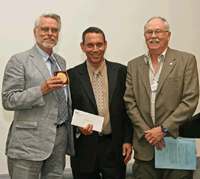2009 Reid Prize Recognizes Outstanding Work in Mathematical Systems Theory
October 18, 2009

With contributions in all fields, Anders Lindquist (left) is truly representative of the work of W.T. Reid,� said SIAM president Doug Arnold in Denver, at the SIAM Annual Meeting. Reid Prize Committee chair H.T. Banks (right) joined Arnold in awarding the 2009 W.T. and Idalia Reid Prize to Lindquist �for fundamental contributions to the theory of stochastic systems, signals, and control.� Lindquist titled his prize lecture �The Moment Problem for Positive Rational Measures: Convexity in the Spirit of Krein.�
Anders Lindquist, a leading researcher in mathematical systems theory, received the 2009 W.T. and Idalia Reid Prize at the SIAM Annual Meeting in Denver. Head of the Mathematics Department and director of the Strategic Research Center for Industrial and Applied Mathematics at the Royal Institute of Technology, in Stockholm, Sweden, Lindquist has made numerous seminal contributions and compiled a stellar research record.
In his early work, on Kalman filtering, Lindquist discovered a novel approach that offered a very fast alternative to the standard matrix Riccati approach. Aside from its practical importance, this work has led over the years to several unexpected and elegant research directions, including a complete parameterization of the rational matrix covariance problem.
Lindquist (with G. Picci) also pioneered a geometric program in stochastic realization theory. His geometric approach to the realization (and partial realization) of stochastic processes has resulted in a new and deeper understanding of numerous systems techniques, including smoothing and subspace identification.
In the 1990s, in collaboration with Chris Byrnes, Lindquist began a major thrust with work on the rational covariance extension problem originally posed by Rudolf Kalman and partially solved by Tryphon Georgiou in his 1981 doctoral thesis. Applying deep methods from dynamical systems, topology, and geometry, Lindquist and his collaborators found a complete parameterization of the rational covariance extension problem. This was a major achievement in interpolation theory, made all the more applicable by a constructive proof of their main result.
Somewhat later, Lindquist, working with Byrnes and Georgiou, extended the methodology to the Nevanlinna�Pick framework and developed a version of analytic interpolation with an additional degree constraint. This powerful body of work on interpolation earned an IEEE Axelby Outstanding Paper Award for the authors and resulted in four U.S. patents in speech and signal processing.
Lindquist's work on rational covariance extension and interpolation has since been applied to many engineering problems, such as asymptotic damping and tracking for discrete-time systems with harmonic disturbances, the inverse problem of simultaneously satisfying interpolation constraint and loop shaping in problems of robust control, and the generalized moment problem for rational measures.--H.T. Banks, for the Reid Prize Committee.

